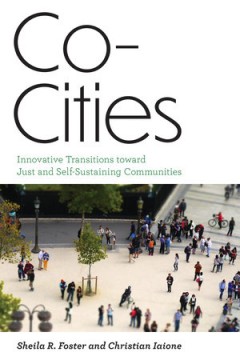Filter by

Men's Experien
This open access book draws on a broad study on violence against men, from both male and female partners in Norway, to contribute to the research on intimate partner violence. It identifies similarities in men's experiences and backgrounds, including in their perceptions of their own victimisation. Marianne Inez Lien and Jørgen Lorentzen argue that the traditional gender power model should be …
- Edition
- 1
- ISBN/ISSN
- 978-3-030-03994-3
- Collation
- -
- Series Title
- Palgrave Studies in Victims and Victimology
- Call Number
- XI, 174

Co-Cities: innovative transitions toward just and self-sustaining communities
"A new framework for experimental and innovative "city-making" for urban resources and services to be developed and governed in a collaborative, socially, and economically inclusive ways"--OCLC-licensed vendor bibliographic record.
- Edition
- -
- ISBN/ISSN
- 9780262369930
- Collation
- 1 online resource.
- Series Title
- -
- Call Number
- -

Extended Non-Equilibrium Thermodynamics : From Principles to Applications in …
- Edition
- -
- ISBN/ISSN
- 9781351021944
- Collation
- -
- Series Title
- -
- Call Number
- -
- Edition
- -
- ISBN/ISSN
- 9781351021944
- Collation
- -
- Series Title
- -
- Call Number
- -

How Europeans Understand Solidarity, Reciprocity and Fairness in the EU: Insi…
- Edition
- -
- ISBN/ISSN
- 9781032690902
- Collation
- -
- Series Title
- -
- Call Number
- -
- Edition
- -
- ISBN/ISSN
- 9781032690902
- Collation
- -
- Series Title
- -
- Call Number
- -

Ethnomusicology, Queerness, Masculinity
This open access book explores the disciplinary, disciplined, and recent interdisciplinary sites and productions of ethnomusicology and queerness, arguing that both academic realms are founded upon a destructive masculinity—indissolubly linked to coloniality and epistemic hegemony—and marked by a monologic, ethnocentric silencing of embodied, same-sex desire. Ethnomusicology’s fetishizati…
- Edition
- -
- ISBN/ISSN
- 978-3-031-15313-6
- Collation
- X, 240
- Series Title
- -
- Call Number
- -

'The Bell Curve' in Perspective
This open access book examines the implications of The Bell Curve for the social, economic, and political developments of the early 21st century. Following a review of the reception of The Bell Curve and its place in the campaign to end affirmative action, Professor Tucker analyses Herrnstein’s concept of the “meritocracy” in relation to earlier 20th century eugenics and the dramatic incr…
- Edition
- -
- ISBN/ISSN
- 978-3-031-41614-9
- Collation
- XIII, 124
- Series Title
- -
- Call Number
- -

The making of grand Paris :metropolitan urbanism in the twenty-first century
A critical examination of metropolitan planning in Paris -- the ""Grand Paris"" initiative -- and the building of today's networked global city.OCLC-licensed vendor bibliographic record.
- Edition
- -
- ISBN/ISSN
- 9780262337014
- Collation
- 1 online resource (viii, 313 pages).
- Series Title
- -
- Call Number
- -

Neuroplasticity
The real story of how our brains and nervous systems change throughout our lifetimes -- with or without ""brain training."""Fifty years ago, neuroscientists thought that a mature brain was fixed like a fly in amber, unable to change. Today, we know that our brains and nervous systems change throughout our lifetimes. This concept of neuroplasticity has captured the imagination of a public eager …
- Edition
- -
- ISBN/ISSN
- 9780262337069
- Collation
- 1 online resource (x, 181 pages).
- Series Title
- -
- Call Number
- -

Sequel to suburbia :glimpses of America's post-suburban future
How the decentralized, automobile-oriented, and fuel-consuming model of American suburban development might change.OCLC-licensed vendor bibliographic record.
- Edition
- -
- ISBN/ISSN
- 9780262330749
- Collation
- 1 online resource (xii, 231 pages) :illustrations, maps.
- Series Title
- -
- Call Number
- -

City and suburb : a novel
CITY AND SUBUKB. CHAPTEE I. A DROP IN THE OCEAN. Late in ihe afternoon of a day in August, Alan Euthven passed under Higligate Archway on his way to London. He was coming to the great city to seek his fortune ; behind him — white, straight and dusty, lay the Great North Eoad he had traversed — before him was the goal he desired to reach ; Riid yet, instead of pushing faster and …
- Edition
- -
- ISBN/ISSN
- 647930393
- Collation
- cdl; americana
- Series Title
- -
- Call Number
- nrlf_ucb:GLAD-151526744
 Computer Science, Information & General Works
Computer Science, Information & General Works  Philosophy & Psychology
Philosophy & Psychology  Religion
Religion  Social Sciences
Social Sciences  Language
Language  Pure Science
Pure Science  Applied Sciences
Applied Sciences  Art & Recreation
Art & Recreation  Literature
Literature  History & Geography
History & Geography